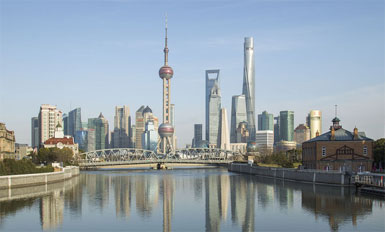The world’s second tallest skyscraper opens this summer in Shanghai, China (the tallest is in Dubai).
At over 2074 feet tall (121 floors), Shanghai Tower, designed by Gensler, is the centerpiece of the city’s financial district – developed from farmland around 20 years ago.
The building will be certified LEED-Gold and has many environmental features. One is that it is the first skyscraper where the entire perimeter is public space and the idea of creating community is woven through the design of the massive structure.
Shanghai Tower is the spiral structure on the right:
Indeed, the building is conceived as a city unto itself. Each of nine zones – every 12-14 floors – has a multistory "sky garden" where people can gather and relax. Retail shops and restaurants are also located in these "vertical neighborhoods," but each zones has a distinct function: retail and conference space at street level, offices above, and hotels near the top.
21 sky gardens – which will show off indigenous plants of China and take up a third of the space – also help to cool the building. They are located between two transparent skins that make up the building envelope. The skins maximize natural light and insulation.
The design team used three strategies to ensure the tower can withstand typhoon-level winds – an asymmetrical form, tapering profile and rounded corners. Its spiral shape has a 120-degree twist which provides the optimal rotation to minimize wind loads, says Gensler, allowing the use of lighter materials to construct the tower and saving $58 million.
A 2130-kilowatt combined heat and power plant, which runs on natural gas, is the main energy source, but exterior lighting and power for the upper floors comes from wind turbines under the parapet. Collected rainwater is used in the heating and air conditioning systems. Overall, the tower will use 21% less energy than if it had been designed conventionally.
The world’s fastest elevators, designed by Mitsubishi, can travel at 40 mph.
"It’s really more a study in urbanism than anything else. "It’s taking the ideas of Shanghai, where you have all these little parks and neighborhoods, and turning it from a horizontal plane to a vertical plane," Daniel Winey, managing principal for Gensler in the Asia-Pacific region, told National Public Radio.
Read our article, Indonesia Gets World’s First Net-Zero Energy Skyscraper.
Gensler’s Fact Sheet:

